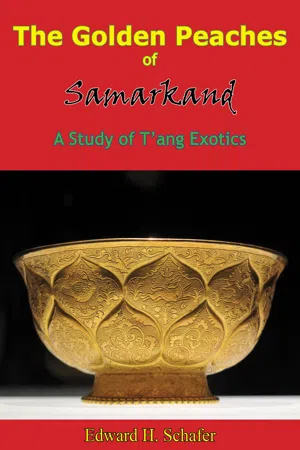
The Golden Peaches of Samarkand
A Study of T'ang Exotics
Edward H. Schafer
- 619 pagine
- English
- ePUB (disponibile sull'app)
- Disponibile su iOS e Android
The Golden Peaches of Samarkand
A Study of T'ang Exotics
Edward H. Schafer
Informazioni sul libro
In the seventh century the kingdom of Samarkand sent formal gifts of fancy yellow peaches, large as goose eggs and with a color like gold, to the Chinese court at Ch'ang-an. What kind of fruit these golden peaches really were cannot now be guessed, but they have the glamour of mystery, and they symbolize all the exotic things longed for, and unknown things hoped for, by the people of the T'ang empire.This book examines the exotics imported into China during the T'ang Dynasty (A.D. 618-907), and depicts their influence on Chinese life. Into the land during the three centuries of T'ang came the natives of almost every nation of Asia, all bringing exotic wares either as gifts or as goods to be sold. Ivory, rare woods, drugs, diamonds, magicians, dancing girls—the author covers all classes of unusual imports, their places of origin, their lore, their effect on costume, dwellings, diet, and on painting, sculpture, music, and poetry.This book is not a statistical record of commercial imports and medieval trade, but rather a "humanistic essay, however material its subject matter.""The most essential thing the reviewer can say about this book is, 'Read it!' It is probably the most informative, most scholarly, and most delightfully written book on China that has appeared in our time. It is a heartening reminder that scholars still have an interest in studying history in terms of people, in examining people's intimate reactions to the little human things that occupied their daily lives."—Jour. of Asian Studies"A pure delight....Scarcely any aspect of T'ang life is omitted, so that bit by bit Mr. Schafer builds up a reasonably complete picture of an entire civilization. Mr· Schafer writes with urbanity and wit."—Sat. Rev."A fascinating survey of T'ang culture as reflected in the use and demand for exotica....Rarely has the reviewer come upon a book so enjoyable and informative·"—Jour. of the American Oriental Society.
Domande frequenti
Informazioni
REQUEST FROM THE PUBLISHER
